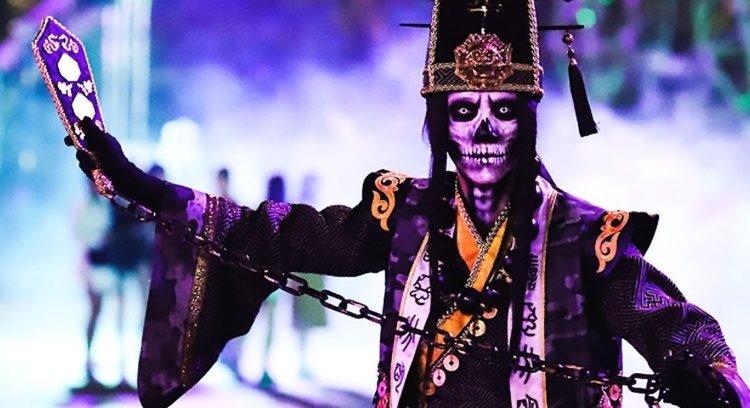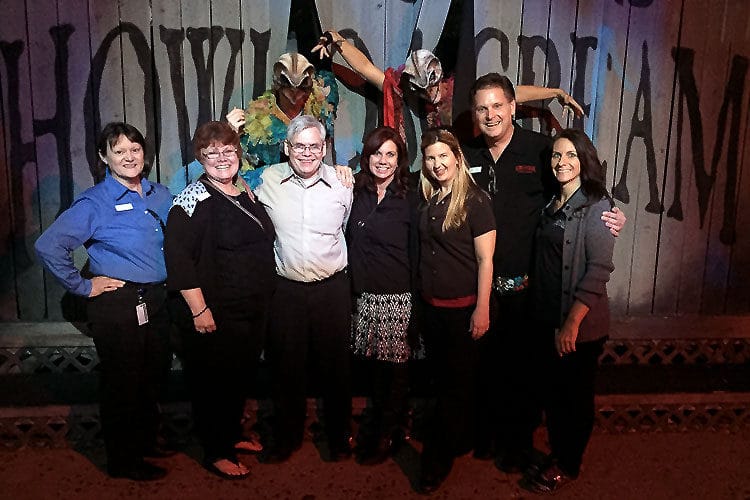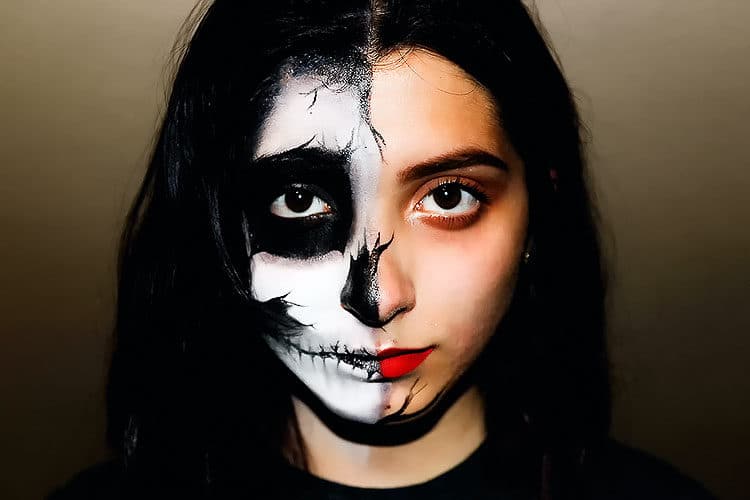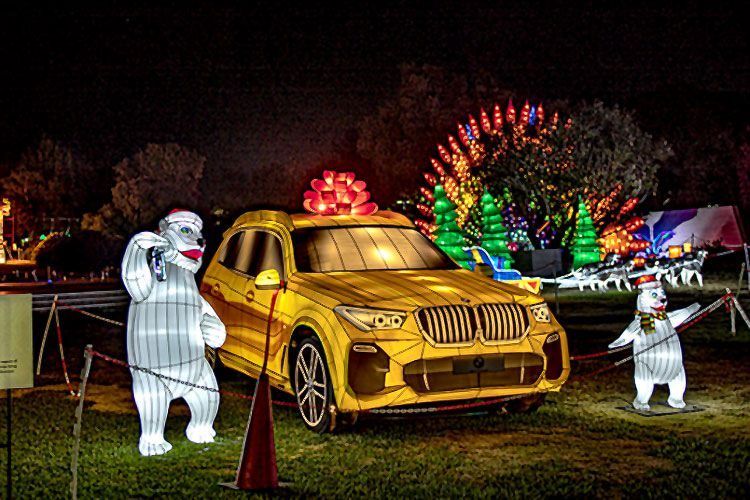The challenges and opportunities of melding Eastern and Western influences into a new kind of horror event
By Philip Hernandez
“Trick or treat!” We all know what that means. Most Americans grew up celebrating or at least aware of Halloween. Halloween is so much a part of American culture—as are horror movies and haunted houses—that it’s difficult to fathom an October without this hallmark event. However, in many places around the world, Halloween was unknown until only recently, and celebrating it became a thing to do even more recently than that.
Hong Kong only began large Halloween celebrations in the last 18 years, and that was due to the debut of one event—Halloween Bash at Ocean Park Hong Kong. In this article, we trace the history of how one of the West’s essential holidays was imported to Hong Kong and transformed into a uniquely Asian celebration.
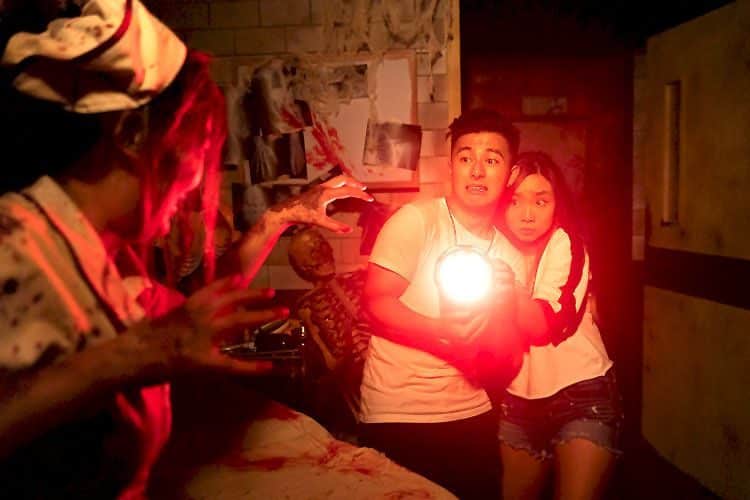
The Current Theme Park and Attractions Landscape in Hong Kong
Hong Kong has a plethora of attractions ranging from scenic natural places to historic sites, Buddhist nunneries to aerial trams, and theme parks to museums. Most target visitors from outside the city, but there are attractions which are popular with locals, just like Disney parks, Six Flags, and other attractions are in the US.
To establish Hong Kong as a tourist destination the Hong Kong Government has been developing various tourist attractions, including Ocean Park Hong Kong (opened in 1977) and Hong Kong Disneyland (opened in 2005).
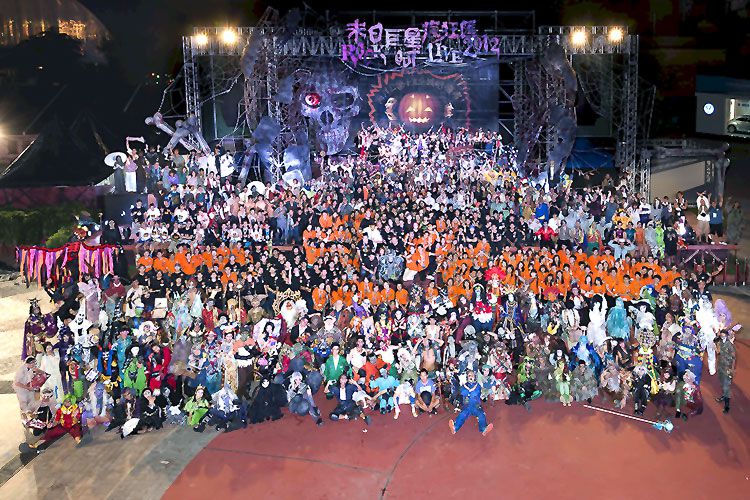
A Brief History of Ocean Park Hong Kong
Ocean Park Hong Kong (referred to as Ocean Park) is a marine mammal park, oceanarium, animal theme park, and amusement park located in Wong Chuk Hang and Nam Long Shan in the Southern District of Hong Kong. It’s the second-largest theme park in Hong Kong; Hong Kong Disneyland is the largest.
Ocean Park opened 42 years ago, and it’s remained consistently popular throughout the decades. By 2014, 7.6 million people were visiting the park annually, and it was the 13th most-visited theme park in the world that year and one of the largest in Asia. However, in 2015, economic and societal concerns about China resulted in decreased overseas tourism to Hong Kong overall, and attendance at the park fell. In January 2017, the park saw a 30% surge in visitors over the same month in 2016, an increase credited to a new mass transit railway (MTR) system in Hong Kong, big discounts, and an early Lunar New Year holiday.
Fiscal Year
Number of visitors
Net change
% Change
2002
3,380,000
2003
3,540,000
160,000
4.7
2004
3,700,000
160,000
4.5
2005
4,200,000
500,000
13.5
2006
4,400,000
200,000
4.8
2007
4,650,000
250,000
5.7
2008
5,100,000
450,000
9.7
2009
4,800,000
(-300,000)
(-6.3)
2010
5,100,000
300,000
6.3
2011
5,900,000
800,000
15.7
2012
7,100,000
1,200,000
20.3
2013
7,700,000
600,000
8.5
2014
7,600,000
(-100,000)
(-1.3)
2015
7,400,000
(-200,000)
(-2.7)
2016
6,000,000
(-1,400,000)
(-23.3)
2017
5,800,000
(-200,000)
(-3.4)
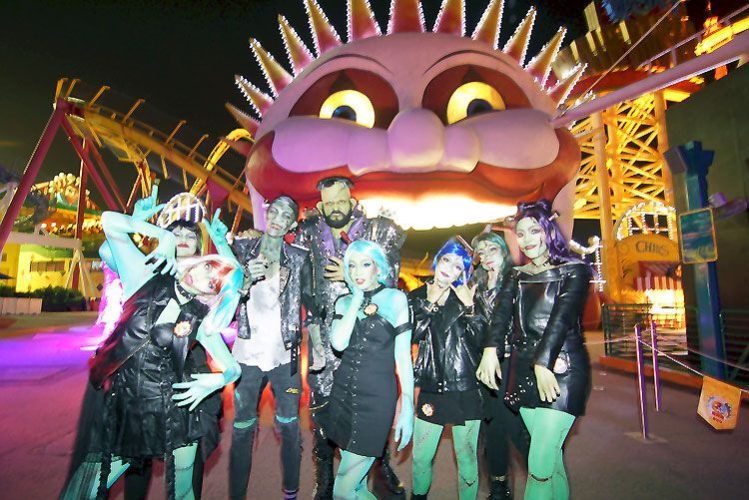
The Ocean Park Halloween Bash/Halloween Fest
In 2019, Ocean Park is renowned for hosting the largest Halloween event in Asia. The Ocean Park Halloween Bash debuted in 2001 as the first Halloween event at any theme park in Southeast Asia, with an investment of $15 million and three flagship mascots—the Pumpkin King, the Witty Witch, and Count Dracula. There were initially four haunted attractions as well as horror shows and games. Staff dressed in costume and did their best to scare guests. More than 150,000 visitors attended during that first season. After the rebrand to Halloween Fest in 2013, the event became an all-day-and-into-the-night, family-friendly attraction. Up to 500,000 people now visit the Halloween Fest annually, making it one of the most highly attended Halloween events in the world.
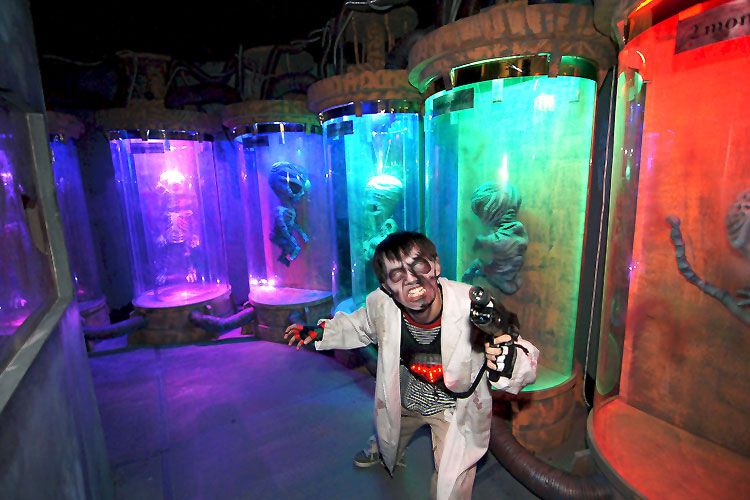
Highlights of the 2018 Event
Halloween Fest 2018 ran from October 5 through Halloween; the dates change each year, always ending on Halloween. The 2018 Halloween Fest still featured staff in costume, but most people came for the haunted houses, which integrate some of the best state-of-the-art technology. The 2018 event had 11 haunted attractions.
New Experiences:
- In ‘X-Dimension’ (Hong Kong’s first virtual-reality—VR—haunted attraction), presented by Yahoo! Hong Kong, guests were trapped by an evil artificial intelligence and surrounded by 360-degree interactive projections and 3D-mapping technology.
- In ‘Undead: Devil Seeker’s Tale,’ presented by Vivo, guests destroyed Chinese devils with augmented reality technology during the day and faced the eighteen levels of hell in the Infernal Spiral at night.
- Hospital of Horrors, presented by com, offered a unique walk-through experience at an abandoned hospital. Guests used ghost hunting devices to navigate corridors and trigger effects.
- Dark Water (Ocean Park’s first-ever underwater themed attraction) plunged guests into a watery abyss of horror.
- In Circus of the Damned, guests encountered creepy clowns and carnival freaks behind the cheery circus stage used in the daytime family event, Circus of Wonder.
Other highlights included three family-friendly attractions created by the Park’s first-ever collaboration with Sanrio—Sanrio characters’ HELLO-ween Party, Sanrio characters’ Trick-or-Treat Trail, and Sanrio characters’ HELLO-ween Meet and Greet. In addition to the family-oriented Circus of Wonder, there was a Halloween Fest SkeleFun VIP tour for kids.
The Park’s Halloween Mine Train, presented by Samsung Gear VR, was revamped last season with an added, Halloween-themed, VR experience where guests shot down zombies using VR headsets. There was also a VR Morgue.
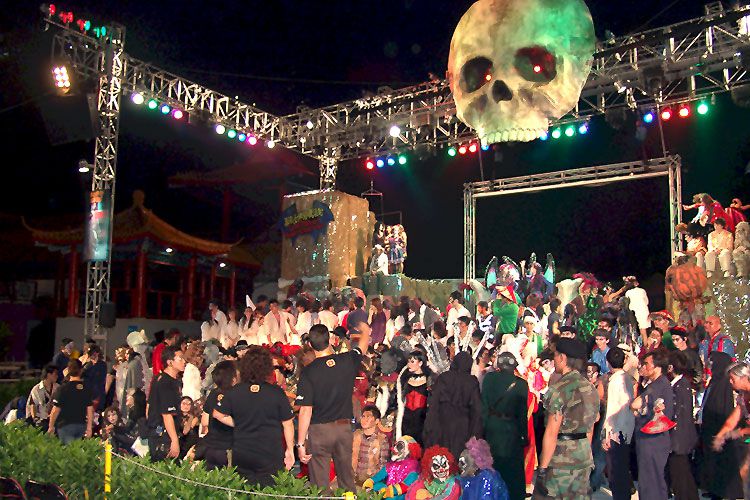
Bringing Halloween to Hong Kong
The Ocean Park Halloween Bash served as the foundation for bringing the Halloween culture to Hong Kong. Halloween celebrations were practically nonexistent at the beginning of the 21st century in Hong Kong, but the holiday is becoming more and more popular among all age groups. Many citizens didn’t know the story of All Hallows’ Eve and hadn’t heard of a haunted house, much less been in one. With the help of media and movies, Western-style demons, vampires, and all things creepy have become part of the horror scene in Hong Kong, which is now considered the Halloween capital of Asia. Just as in the US and other countries, Halloween costumes and candy can be found at shopping centers as early as August, and the holiday has become a big deal. Halloween parties are particularly popular, and a Halloween party in Hong Kong is like no other.
From its inception, Ocean Park brought in experts from the Western haunted attraction industry as directors of the Halloween Bash/Fest. Among the industry leaders who’ve contributed to Halloween Bash/Fest are Todd Hougland, Alan Ostrander, and Joel Talacko, each of whom we had the good fortune to talk about their contributions and challenges in bringing Halloween to Hong Kong.
About Todd Hougland, Alan Ostrander, and Joel Talacko
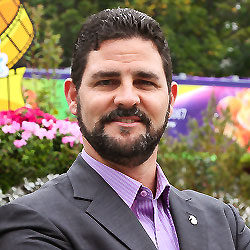
Todd Hougland is the former Executive Director of Ocean Park Hong Kong. As an IAAPA Certified Attractions Executive (ICAE), Todd provides international theme park executive leadership and has over 30 years of experience in a variety of projects and posts across North America, Europe, and Asia. Todd is currently the General Manager of Producers Group Orlando.
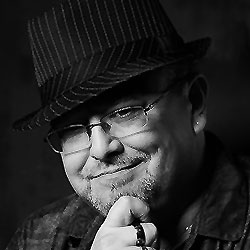
Alan Ostrander is the Former Designer, Director, and Artist at Ocean Park Hong Kong and is currently the President/Creative Director of Make-Up, Special-FX, Design, and Production at AEO Studios, Inc. Since 1984 Ostrander has been a professional theatrical artist throughout the US, Thailand, Hong Kong, Japan, and Argentina.
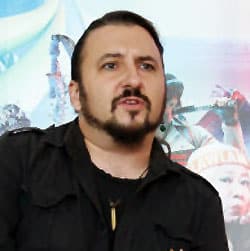
Joel Talacko is the Haunted Attraction Director for Ocean Park Hong Kong’s Halloween Fest. Joel has designed more than 70 attractions as a haunted attraction and event designer including Recycle, Child’s Eye, Rigor Mortis, AMC’s The Walking Dead, and Doreamon.
Baseline: The Early Years
Halloween Bash’s evolution is an educational model for tourism development in any new market. Since Ocean Park brought Halloween to Hong Kong, increasingly more theme parks in mainland China have added the event to their annual calendar.
“When we were first invited over in 2001, Hong Kong had no idea what Halloween was,” said Ostrander. We were tapped to design all the makeup and characters during that first year. [Ocean Park] called us the second week in October and asked, ‘Can you be here Monday?’ It was fast and furious. That first year, we only ran two weekends,” he explained.
“People were curious about the event but hesitant about coming to see it,” said Ostrander. “By the second year, it seemed like everyone in Hong Kong came to see the show, and it just exploded from then on. It appeared that the locals had embraced the whole Western holiday of Halloween,” he said.
Talacko’s team directed performer training for the Bash. “Every day, we did special-effects prosthetic makeup and got the specialty performers out before we went to our directing duties,” he said. In the preseason, Talacko helped with the design of the attractions. Talacko’s introduction began in 2005, soon after Tom Mehrmann became CEO. Mehrmann served as CEO of Ocean Park Hong Kong from 2004 to 2016
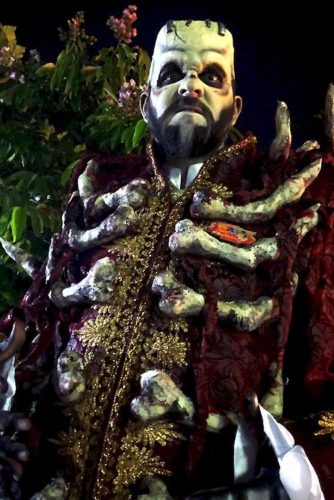
“This new management team had much experience in Orlando and California parks as well as theme parks around the world. They provided the opportunity to bring Ocean Park up to a world-class standard, and not just for Halloween,” said Talacko.
Over the next three years, Ocean Park added haunted houses —seven in 2007, eight in 2008, and nine in 2009. A decision was then made not to add more attractions but more shows and more roving characters. By 2013, when the event expanded and rebranded to take place during the daytime as well as at night, there were two, utterly different attraction entertainment concepts in the same location—two, entirely separate walk-through experiences. By changing the rooms, changing the audio, changing the lighting, and changing the performers, 10 unique attraction experiences were created along with a dozen stage shows and 700 performers. Tom Mehrmann, Todd Hougland, and Alan Ostrander were three people instrumental at getting this show together.
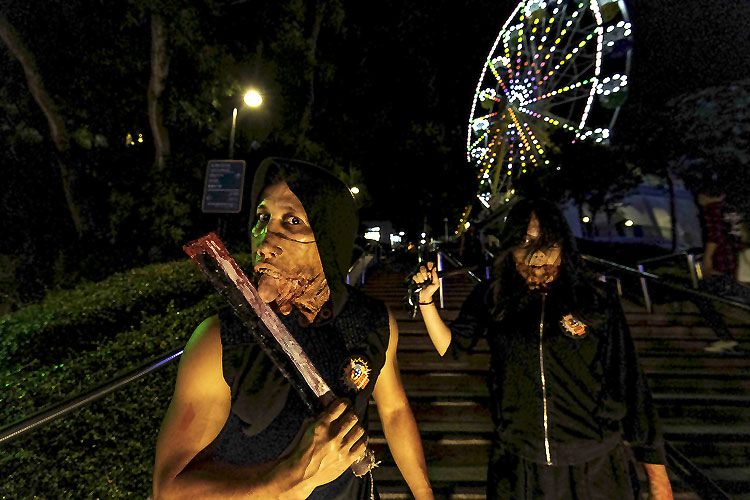
Keys to Ocean Park’s Success
Growing Halloween Bash for the past 18 years has consistently pushed the creativity of the team. Integrating Asian culture with the Western tradition of Halloween proved not only the paramount challenge but the greatest differentiator of the event. It was an entire project to build a team that balanced Western with Asian perspectives and talent for the best possible outcome.
Several keys to Ocean Park’s success in growing Halloween Bash include:
- Integrating Eastern and Western aspects of horror culture
- Discovering and capitalizing on what people are already afraid of
- Melding input from local experts with direction from imported consultants
- Finding, training, and retaining talent
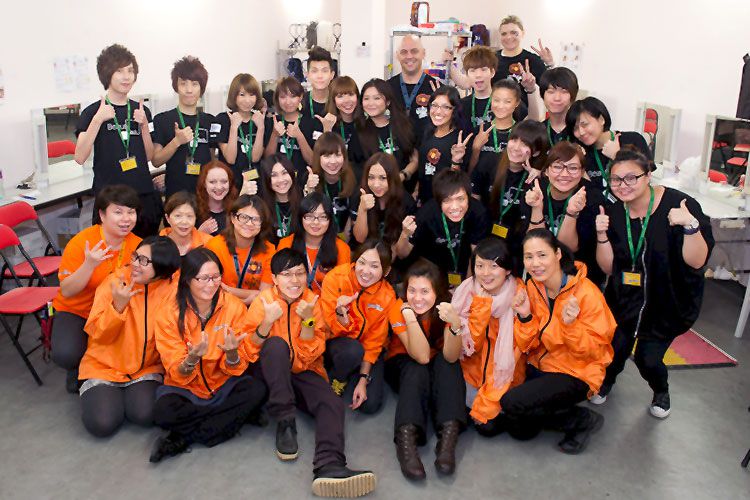
Integrating Eastern and Western Aspects of Horror
The biggest challenge for the Halloween Bash—and what made Ocean Park such a success—was the emphasis on research and integration. Ostrander and his team spent months out of the year researching local traditions and finding out how to incorporate those.
“In 2004, the first Chinese-themed haunted house was introduced to Halloween Bash. Earlier that year, I learned that two of the most popular characters the previous year were what we called ‘photo roving’ characters who wore very, very ornate costumes. They weren’t there to scare guests as much as to be available for photos, which is a big part of Asian culture. Everybody wanted to have a picture taken with these unique characters,” Hougland explained.
The Chinese Bride and Bridegroom were ghosts dressed in traditional Chinese costumes. When Hougland heard about the couple’s impact, he suggested a haunted house based on those two characters. “It was the most popular attraction in 2004 because it was Chinese-themed,” said Hougland.
Additional Asian characters appeared over the years to balance out Western themes. “These storylines meant something to the local market, so we did some that were Hong Kong-based and some that were more generally Asian. A few of these might not have been very relevant to Hong Kong, but they still had an Asian feel. Going forward, we found great success developing attractions in this way.” Incorporation of O Day and Paper Dolls are two specific integration examples
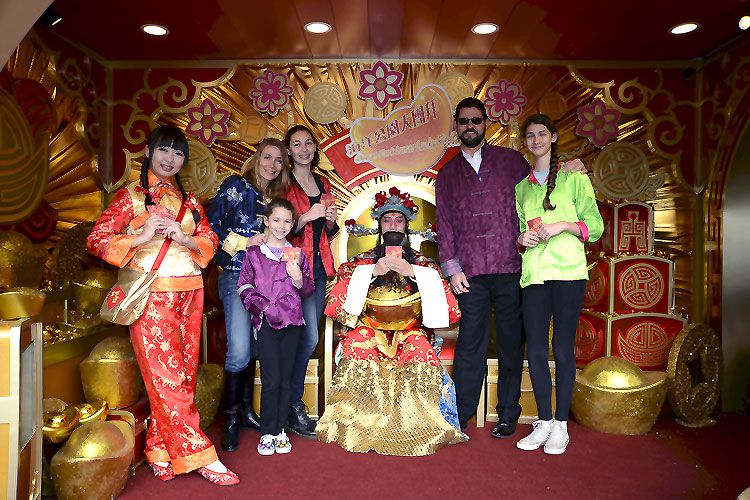
O Day
When young adults go to university in Hong Kong, there’s an orientation day, which they call O Day. Part of O Day is hearing about all the ghost stories at that particular Hong Kong university or, sometimes, at other universities in Hong Kong. O Day ghost stories are a large part of student life.
Ocean Park created an attraction centered around O Day and university life in general. Every scene was a different story that university students would have heard on O Day. “Because our target market knew these stories, as they walked from room to room, it was certainly much more impactful than walking through a medieval dungeon of torture devices,” Hougland pointed out.
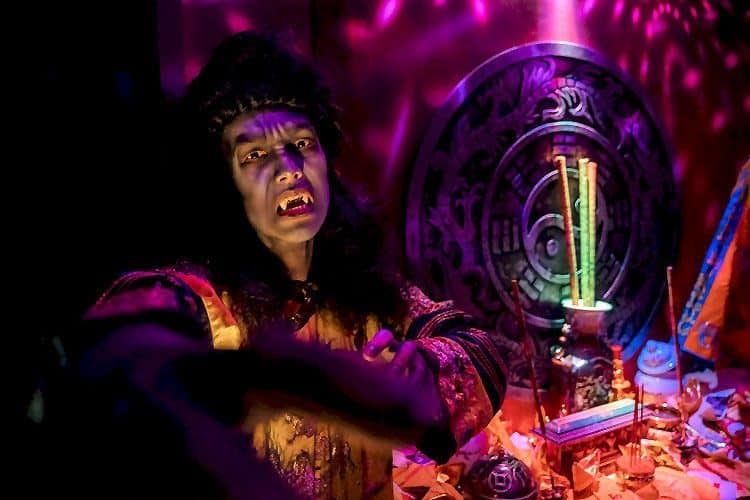
Paper Doll World
One of the scariest attractions that Ostrander designed for Halloween Bash was Paper Doll World (2008). Local myths and folklore infused the attraction. Westerners found it scary, but it wasn’t all that impactful for them,” said Ostrander. “For the locals, however… well, we had many people that wouldn’t even enter the attraction just because of the mythology,” he explained.
Discovering and Capitalizing on What People are Already Afraid Of
Tapping into what a market already fears is a goal for any haunt. Until late in the last century, people in Asia weren’t that familiar with werewolves, vampires, iconic movie characters such as Freddie Krueger, or distinctly Western forms of terror like killer clowns and chainsaw-wielding maniacs. Ghosts were and still are the mainstay in much Asian horror (both in folklore and in movies). Ocean Park used this insight to powerful effect by creating haunts with storylines based on well-known, classic Asian ghosts. As Ostrander put it, “Guests were dropping like flies or were so scared they wouldn’t even go into a haunted house. Things they find horrifically frightening, we look at and think, ‘Okay, it’s a guy with paper circles on his cheeks. So?’ They’d never seen a physical incarnation of those beliefs, and the reaction was total fear,” he said.
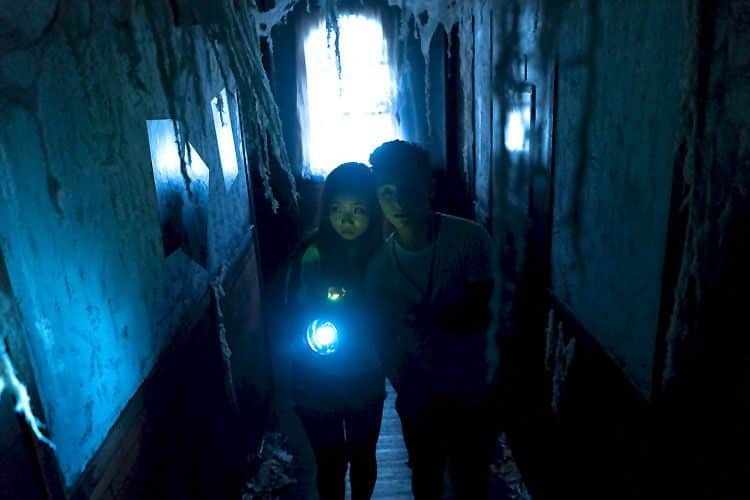
Balance: Melding Input from Local Experts with Direction from Imported Consultants
Western support was critical to Ocean Park, because local talent pools weren’t developed for haunted attractions. In 2004, Hougland realized he needed more show direction—somebody with theatrical experience. There were people in Hong Kong who had this, but they didn’t have experience in how to put the scare actors together and not impact throughout.
Hougland brought in a professional director from Hong Kong who had years of experience at various venues. Together, they came up with how to translate Ocean Park’s expectations for the Halloween event to Hong Kong talent. Bringing in Western influences was important but didn’t obviate the need for local management and local talent.
“After the first couple of years, when the event started growing, we were able to bring over probably a dozen makeup artists each year from the US to complement the character development and makeup aspect. In addition to the artists that we brought over as part of the AEO team every year [AEO is Ostrander’s company], we also contracted about 40 local makeup artists and students to supplement our team,” Ostrander added.
Starting in 2006, “stunt coaches were brought in, and the haunts were taken to a whole new level—not just compared to what guests had seen in China but compared with anything here in the US,” said Ostrander.
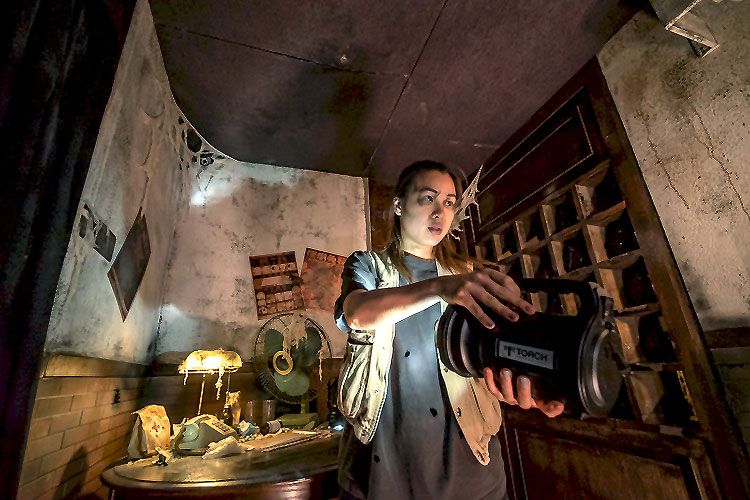
Creating a Uniquely Asian Halloween Experience
Local teams are essential for cultural and market insight. It’s a delicate balance when outsiders come into a space and try to adapt local stories.
“I assembled an excellent team, and I trusted that team. My role was to help guide [the team] to a better event and to help lay out the high-level objectives. Before we started talking about any of the themes or storylines for the next year’s event, we had to work on the question of capacity, adding new attractions, and creating little nodes of entertainment, whatever those might be. Every year, we’d come up with four, five, or six objectives,” said Hougland.
Regarding storylines, the team would brainstorm. During the first few years, Hougland was a part of this process, but he looked to the locals for guidance. He’d say, “Okay, here’s the mix: we’re going to have six haunted houses, and we’re going to have two shows. We want at least three of those attractions to be Asian—two of them Hong Kong Asian and one non-Hong Kong Asian. Maybe it’s Japanese or whatever’s unique and colorful.” The team had the latitude to work through ideas, he explained.
Not surprisingly, the local team came up with Chinese themes 99% of the time. Sometimes these would need some finessing, and Hougland’s role as the designer was to help shape the concept while being aware that the locals knew the ghost stories and storylines that were relevant to that market.
The most significant factor in Halloween Bash’s success was the team’s collaboration, added Ostrander. “The park had an incredible technical team that was able to produce pretty much whatever we came up with. The Hong Kong folks were helpful in informing decisions on themes and helping us understand what was scary to them. Then we came in with all the logistics of layering in the boos and the impacts on top of that,” he said.
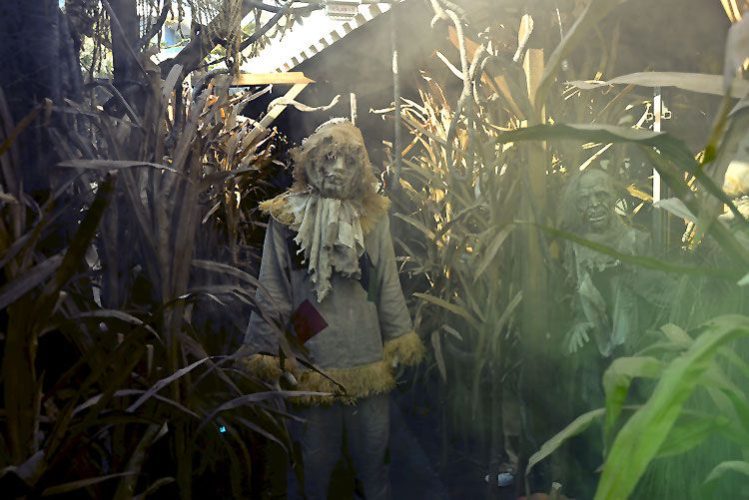
The Challenge of Finding, Training, and Retaining Talent
Although the Halloween show directors were from the West and the talent managers were often local, the team did great work together despite the language challenges. However, scaling is another hurdle altogether. The biggest staff issue was finding 1,000 performers and learning how to approach them, train them, and retain them.
Hougland pointed out that it was difficult to find the necessary talent in Hong Kong. “There’s a small pool of trained performers, and we quickly exhausted that as well as the performers interested in working in this type of show scenario versus traditional theater. After that, the talent pool was very, very shallow,” he explained.
University students provide a large talent pool in the US, but, in Hong Kong, the expectation is that students should be studying. Students won’t take time off or distract themselves from their studies. Their point of view—and that of their family—is that studying is what they should be doing. So, Hougland couldn’t count on the universities as a source of part-time employees. “This turned out to be something of a roadblock,” Hougland said.
“At the same the time that I was searching for talent, the event was growing exponentially. We went from 80 performers one year to 250 the next. When I say 250 performers, that was per night on the streets and in the houses. We needed qualified talent coaches who could watch the performers and give them notes on a nightly basis,” Hougland explained.
Hougland initially brought in local performers along with those from the US. When the Halloween event was up to 400 performers per night, it was necessary to recruit beyond US and local folks. Hougland sent out a tender to talent agencies for performers, whether that be from mainland China or another country. Thus, agencies brought in 100 performers a night from the Philippines. The agency is responsible for casting, obtaining visas, bringing the performers from the Philippines, housing them in Hong Kong, and managing them. After setup, talent is handed over to Hougland’s coaches and casting team within the event. The overseas performers worked with the locals and, because of language, they could often only perform non-speaking roles (grunting or screaming).
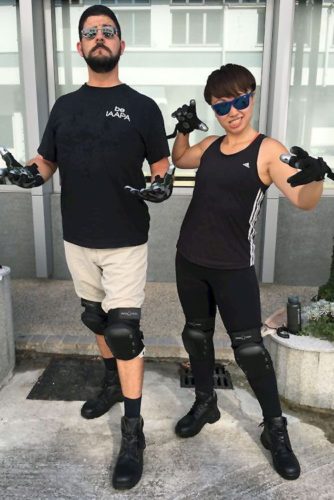
As every scare attraction knows, actors can make or break the experience, so proper training of performers is critical. “I’ve found the most successful haunt is the actor-driven show,” said Ostrander. “I’ve seen terrifying attractions that were put together with a $30,000 budget and a lot of good volunteer actors. I’ve seen other attractions that had budgets of $300,000 or $400,000 that were just okay. It’s not the money that you put into it, it’s the ability to get into people’s heads,” he said.
Convincing performers—especially Chinese performers—to be extroverts was the next hurdle. Performing ‘evil’ roles was difficult, because that flew in the face of cultural expectation. In the Asian culture, young people don’t speak first. They wait until they’re spoken to by an elder. “Well, when there’s a roving character out there with a chainsaw, I need him to be an extrovert, and that was very much a challenge,” said Hougland. His team was fortunate in that many of the performers he hired were trained actors. At one point, Hougland taught demos in the theater department at Hong Kong University, and that became a source of talent. However, even with those students, “it was very much a fight to get them to be the protagonist and engage guests,” he said.
Luckily, Ocean Park performers returned each year, so the actors were able to develop scaring and extroversion skills. “Initially, the performers we recruited were awesome on stage, but if we threw them into a crowd and asked them to improvise, they’d freeze up, because they didn’t have those skills,” Ostrander said. When he was rehearsing and directing actors for the Halloween Bash, he developed a comprehensive training program that involved three to four weeks of full classes on acting and improvisational exercises. Ostrander discovered that if an actor played a character opposite their usual persona, it was easier. “They felt it didn’t reflect negatively on themselves. They were able to come out of themselves and expand on their characters,” said Ostrander.
Talacko also worked with actors. He commented that 25% to 50% of the new performers at the Halloween Bash/Fest had never even been inside a haunted house, so they didn’t come in with preconceptions. Most of them had never watched horror movies, so they didn’t have preconceived notions of how they should perform. They were like a blank slate, he said. “Sometimes that works out well, whereas, at other times, it’s painful, because they can’t fall back on something familiar. It takes training to get them into the space, but you get less of the cookie-cutter effect we often see in the States,” he explained.
A lot of the performers at the Ocean Park Halloween event are young. They’re either still in school or just out of school and, in Hong Kong, school is stressful, Talacko noted. Students are pushed hard by their parents to do well in their studies. “This rigidity also makes it hard for a lot of them to come out of their shell when we want them to perform, because they’ve been taught to be quiet and respectful. So, we decided to work the school experience into a couple of haunted house stories—characters would throw themselves off a building because they failed a particular test that was all-important,” he said.
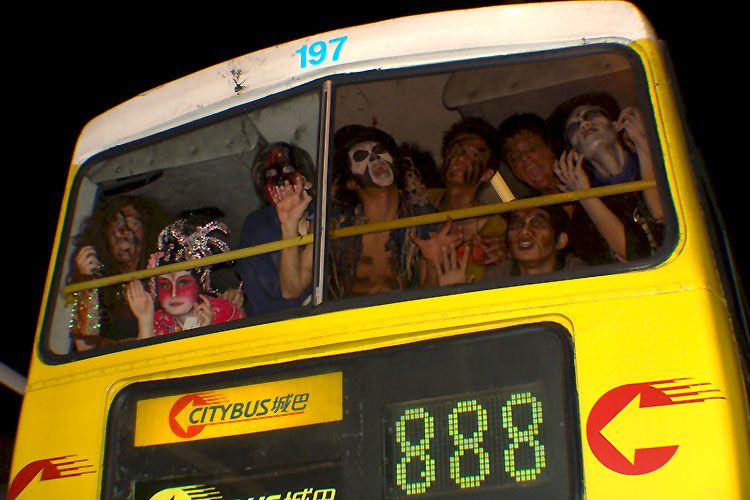
Opening Up Performers to Their Potential in the World
The Halloween event loses performers every year because of stigma. “This isn’t a career. This is just your two-month job. You need to give that up and do something real.” These are comments made by parents and peers to potential actors that the local team faces every year. Ostrander has a very different take on the value of the Ocean Park experience: “In some cases, it feels like we’re opening their minds to their potential. They might have a horrible day at school or work or feel that, in their normal life, they have no control, people walk on them, they can’t stand up for themselves, and they don’t matter. Even if that’s how they feel, we teach them that when they come to the show and put on their character, they can make choices, they have the power to influence and affect thousands of people every night, and they matter.” The Ocean Park team emphasizes the connection with guests; performers can be impact guests for days, weeks, or even years later if the show is amazing. They might give people nightmares. They might make them laugh years from now because they were able to scare a guest’s friend. “They could earn a piece of immortality just by doing this job well and giving themselves over to it. That’s something that working at a nine-to-five job isn’t going to give them,” he said.
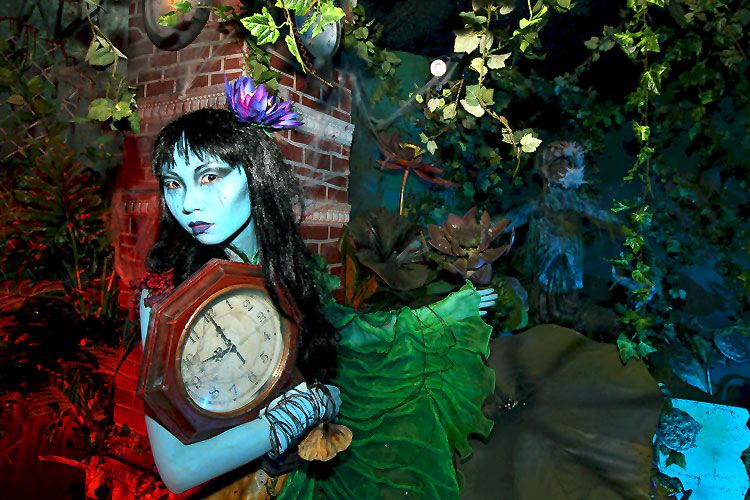
Key Takeaways:
Hong Kong only began large Halloween celebrations in the last 18 years, and that was due to the debut of one event—Halloween Bash at Ocean Park Hong Kong.
Ocean Park opened 42 years ago, and it’s remained consistently popular throughout the decades. In 2019, Ocean Park is renowned for hosting the largest Halloween event in Asia. The Ocean Park Halloween Bash debuted in 2001 as the first Halloween event at any theme park in Southeast Asia.
With the help of media and movies, Western-style demons, vampires, and all things creepy have become part of the horror scene in Hong Kong, which is now considered the Halloween capital of Asia.
Ocean Park brought in experts from the Western haunted attraction industry as directors of the Halloween Bash/Fest over the years. Among the industry leaders who’ve contributed to Halloween Bash/Fest are Todd Hougland, Alan Ostrander, and Joel Talacko
By 2013, when the event was expanded and rebranded to take place during the daytime as well as at night, there were two, completely different attraction entertainment concepts in the same location—two, entirely different walk-through experiences.
Putting together Ocean Park’s Halloween Bash/Fest and keeping it growing and fresh for the last 18 years involved unique challenges and opportunities, the biggest of which was integrating Asian culture and themes with the Western tradition of Halloween.
There keys to Ocean Park’s success in creating and maintaining its Halloween event were:
- Integrating Eastern and Western aspects of culture and horror
- Discovering and capitalizing on what people are already afraid of
- Melding input from local experts with direction from imported consultants
- Finding, training, and retaining talent
The magic moment for the Ocean Park Halloween Bash happened around 2006 or 2008, when a directorial team from the US was brought in and each member of that team was matched with a local assistant director, so there was a mix of Western and Eastern cultures, mythology, and interactions. According to those who worked at the Halloween Bash/Fest over the years, that was the biggest key to the event’s success.
About The Author
Philip Hernandez
Philip Hernandez is a freelance writer, speaker, producer, and marketer specializing in Seasonal Attractions.
In 2018, Philip became the CEO at Gantom Lighting & Controls, a manufacturer of the world’s smallest DMX LED lighting. Gantom is used in every major theme park worldwide to illuminate where other fixtures cannot.
Since 2014 Philip has published Seasonal Entertainment Source magazine (SES), a quarterly print publication for the seasonal attraction professional. SES ships to readers in over 18 countries.
Philip operates the Haunted Attraction Network (HAN), the largest global media entity for the haunted attraction industry. HAN includes written content, videos, a series of podcasts, and the Haunt Design Kit brand.
Philip produces the Leadership Symposium for Seasonal Attractions, a masterclass series for seasonal attraction professionals. Watch more here.
Philip co-hosts the ‘Marketing your Attraction’ podcast monthly. Listen here.
Contact Philip for projects here: [email protected]
